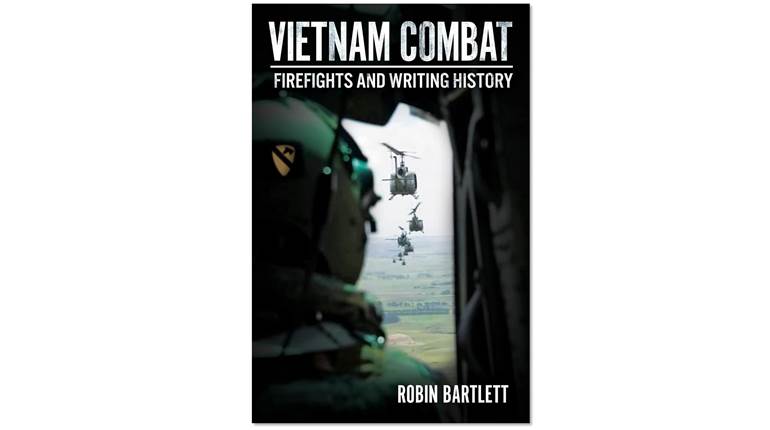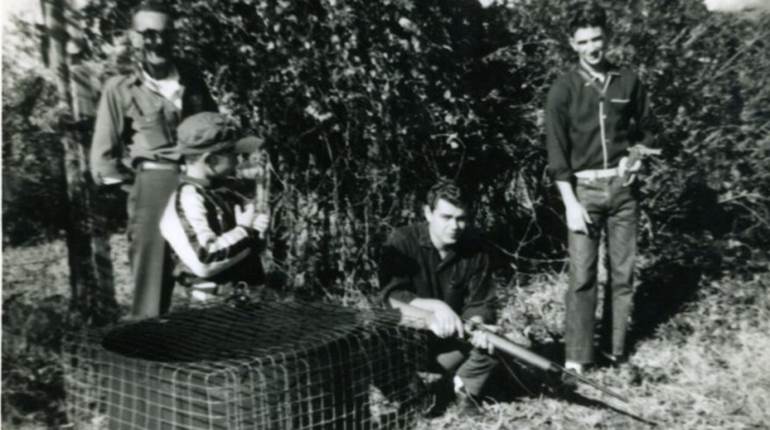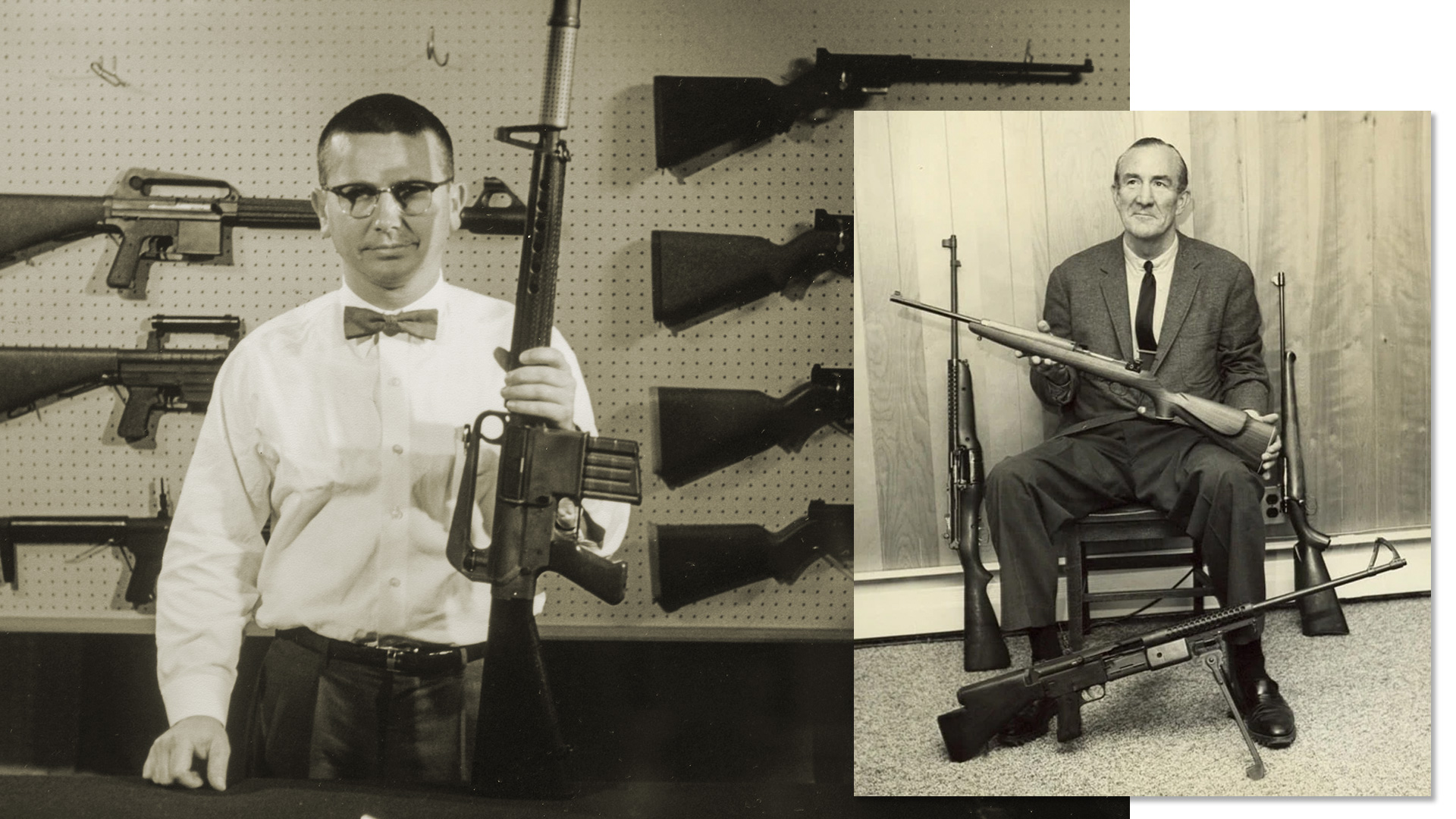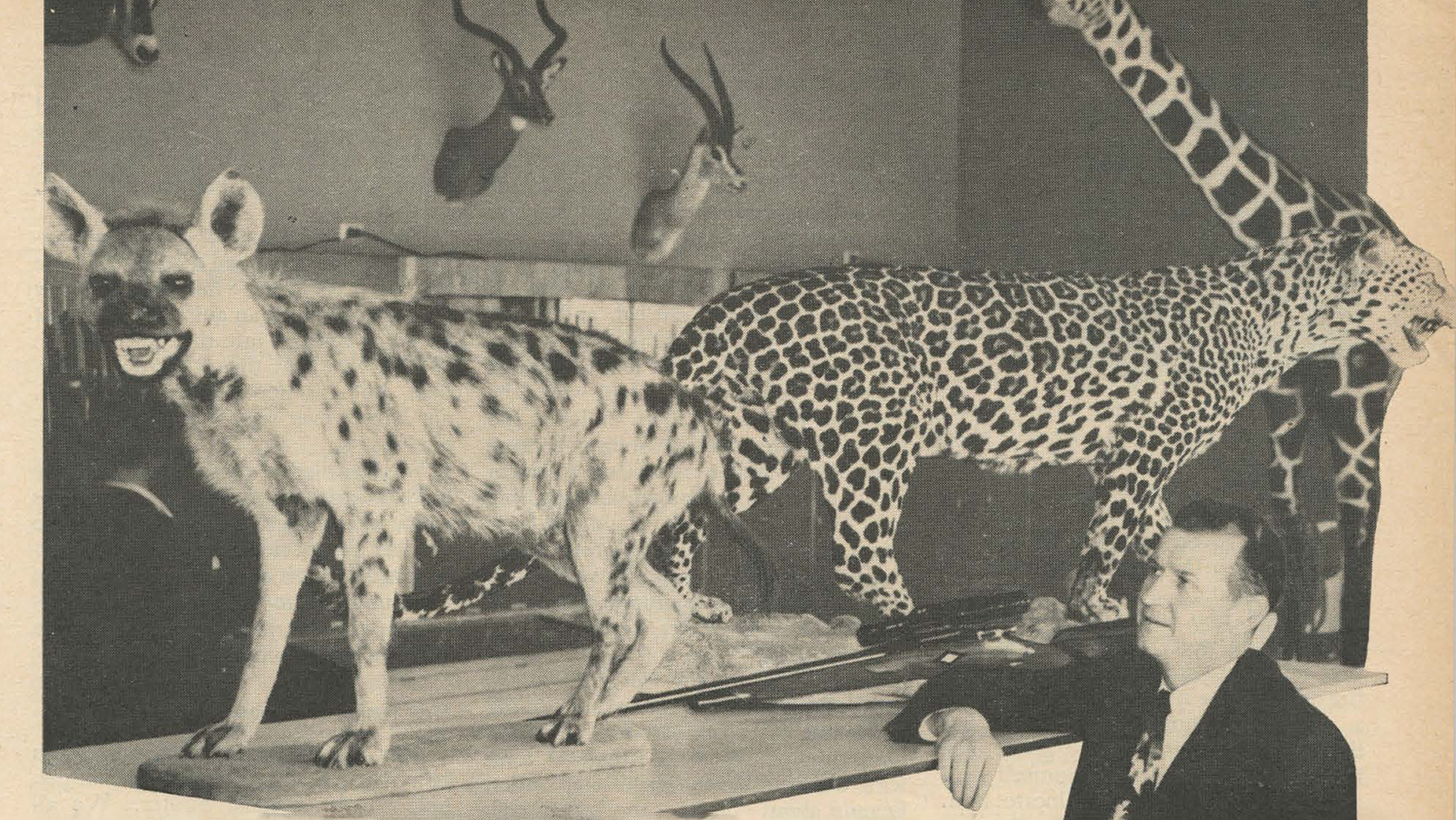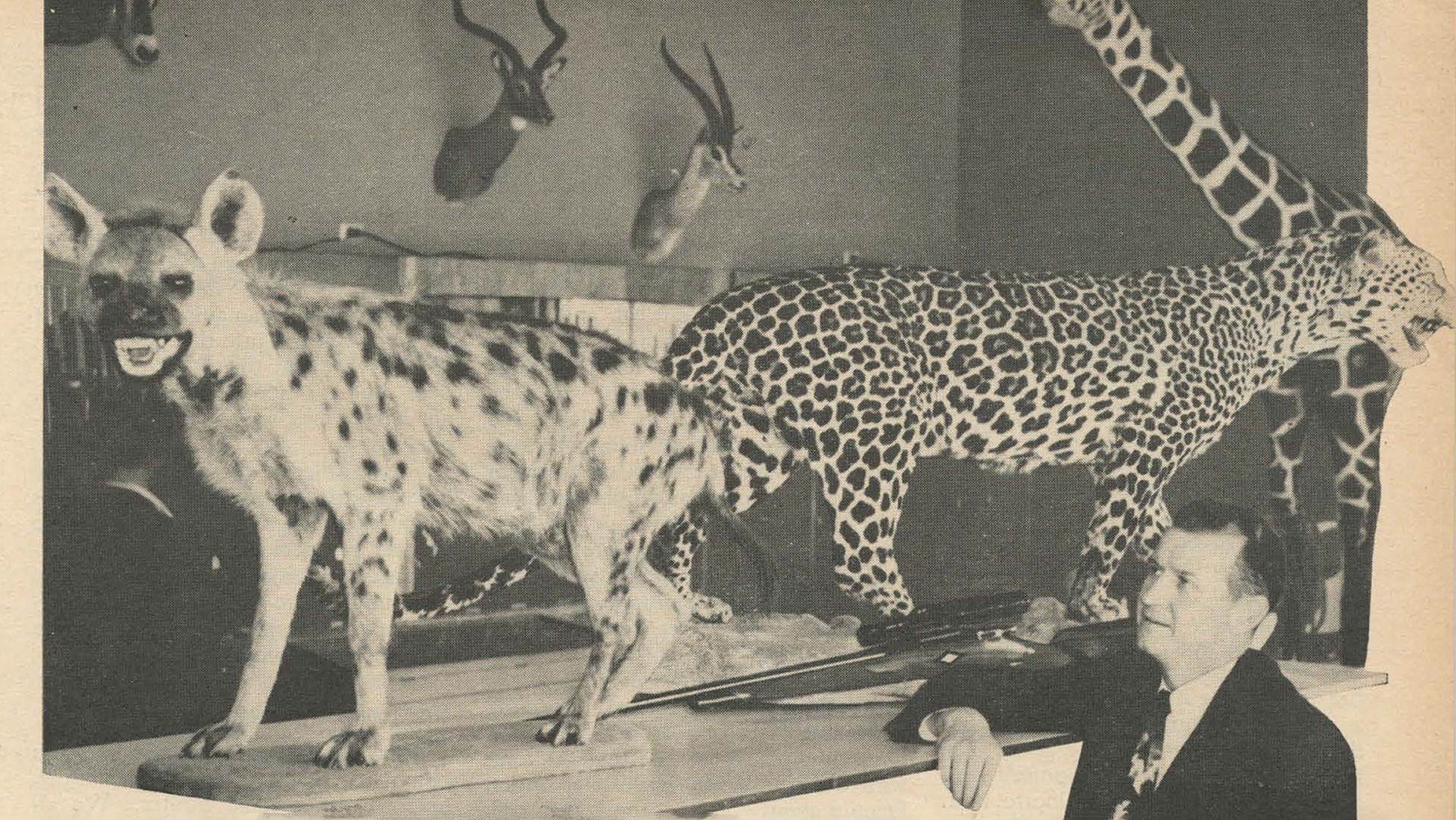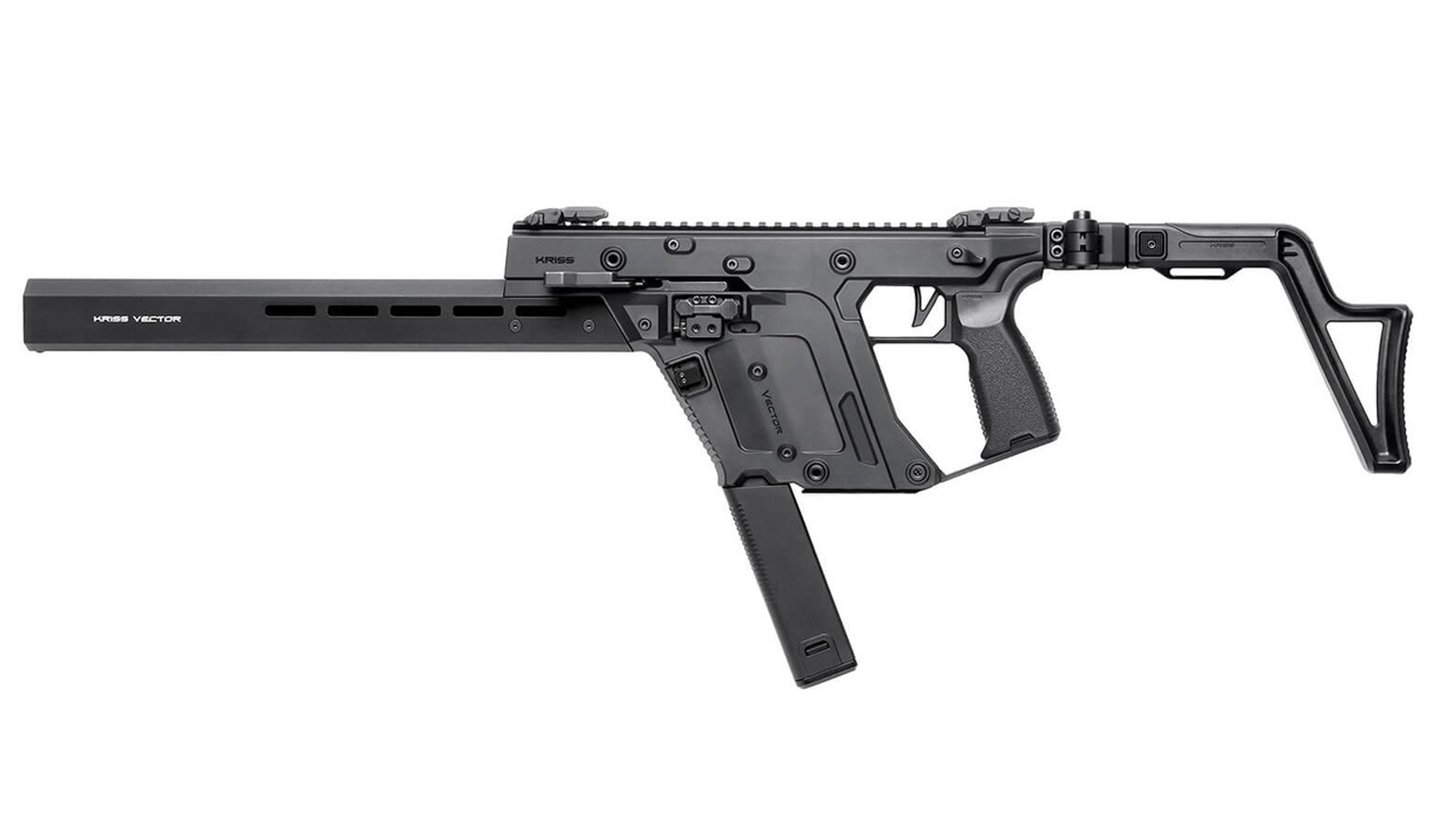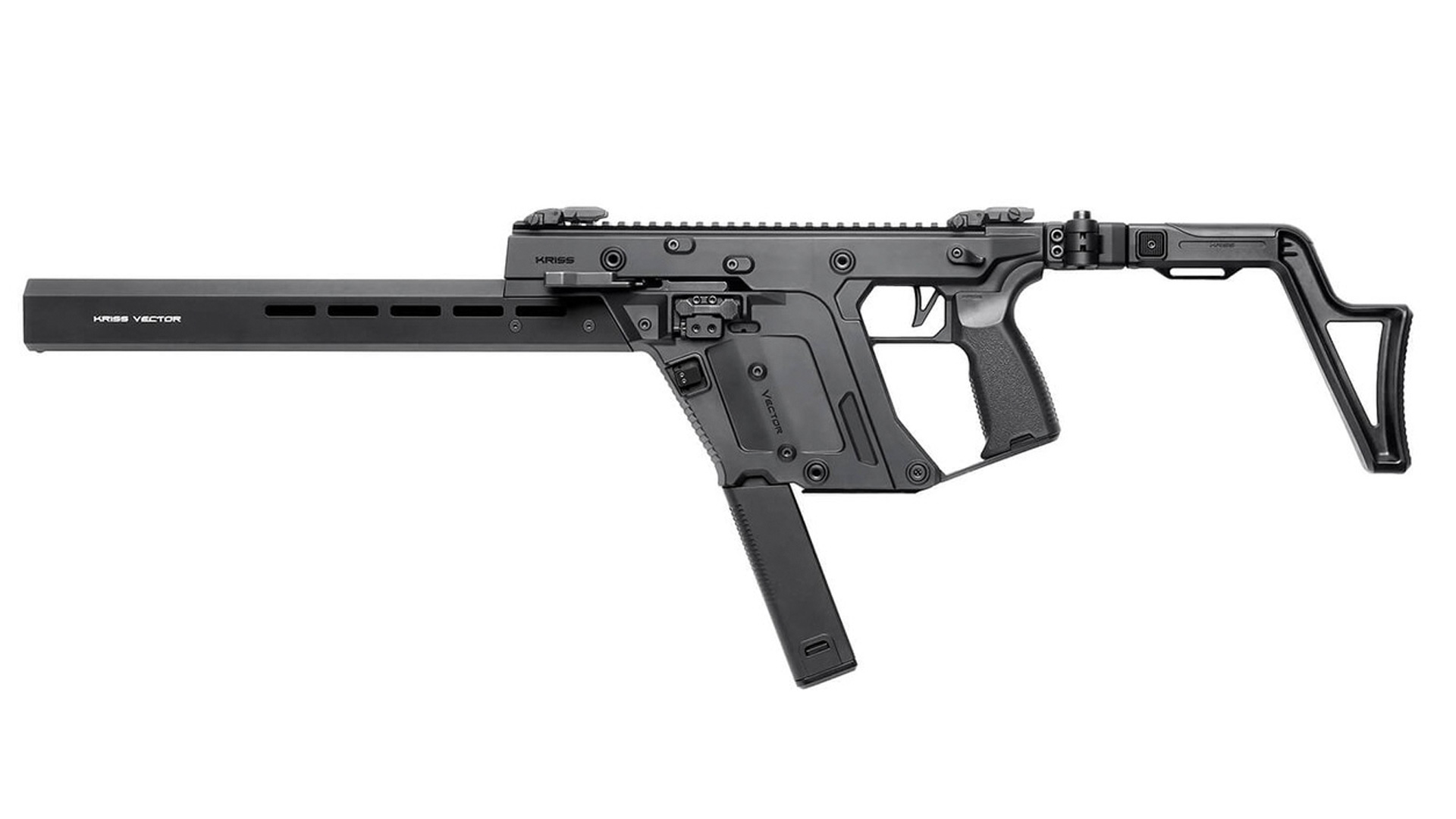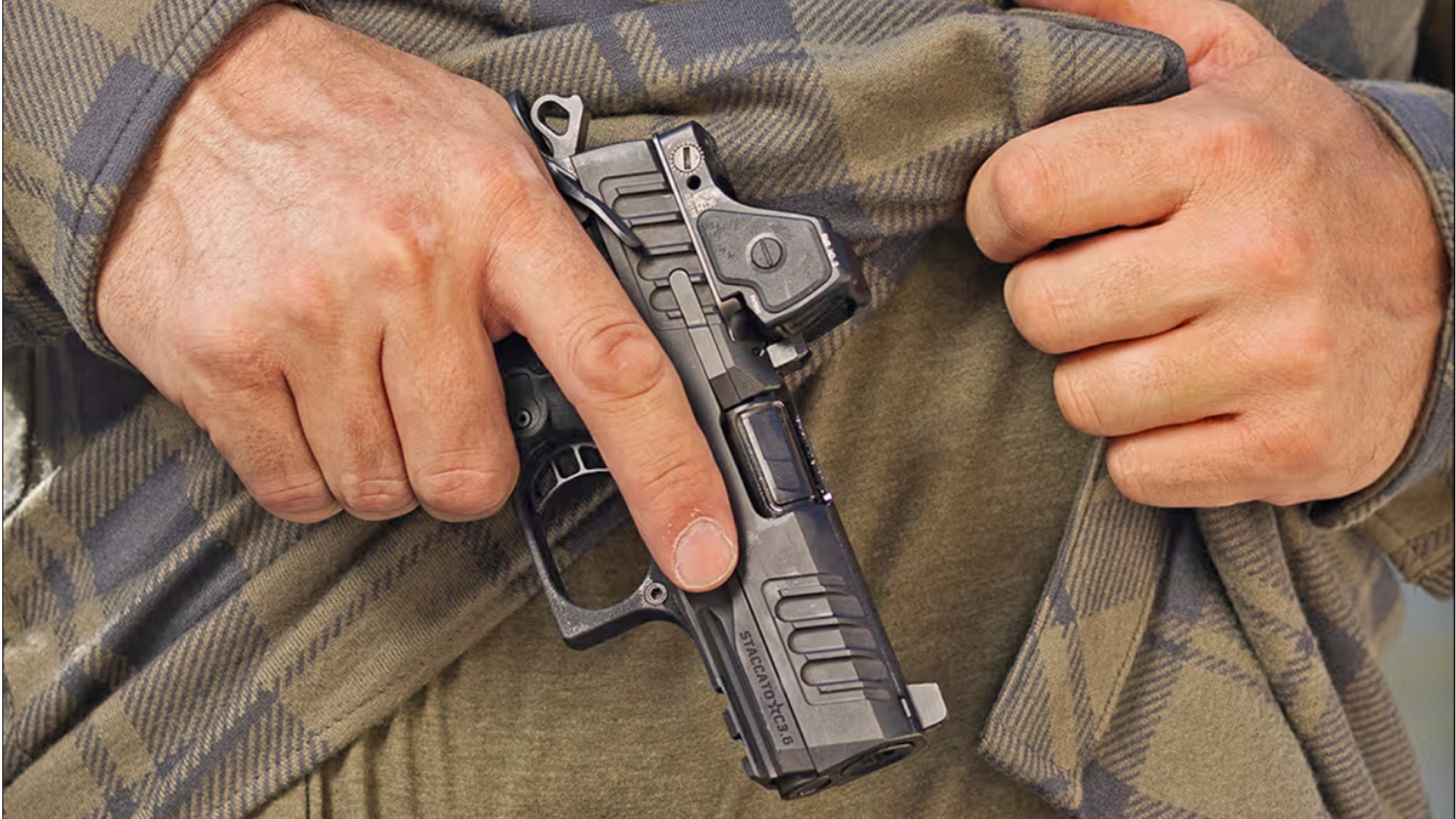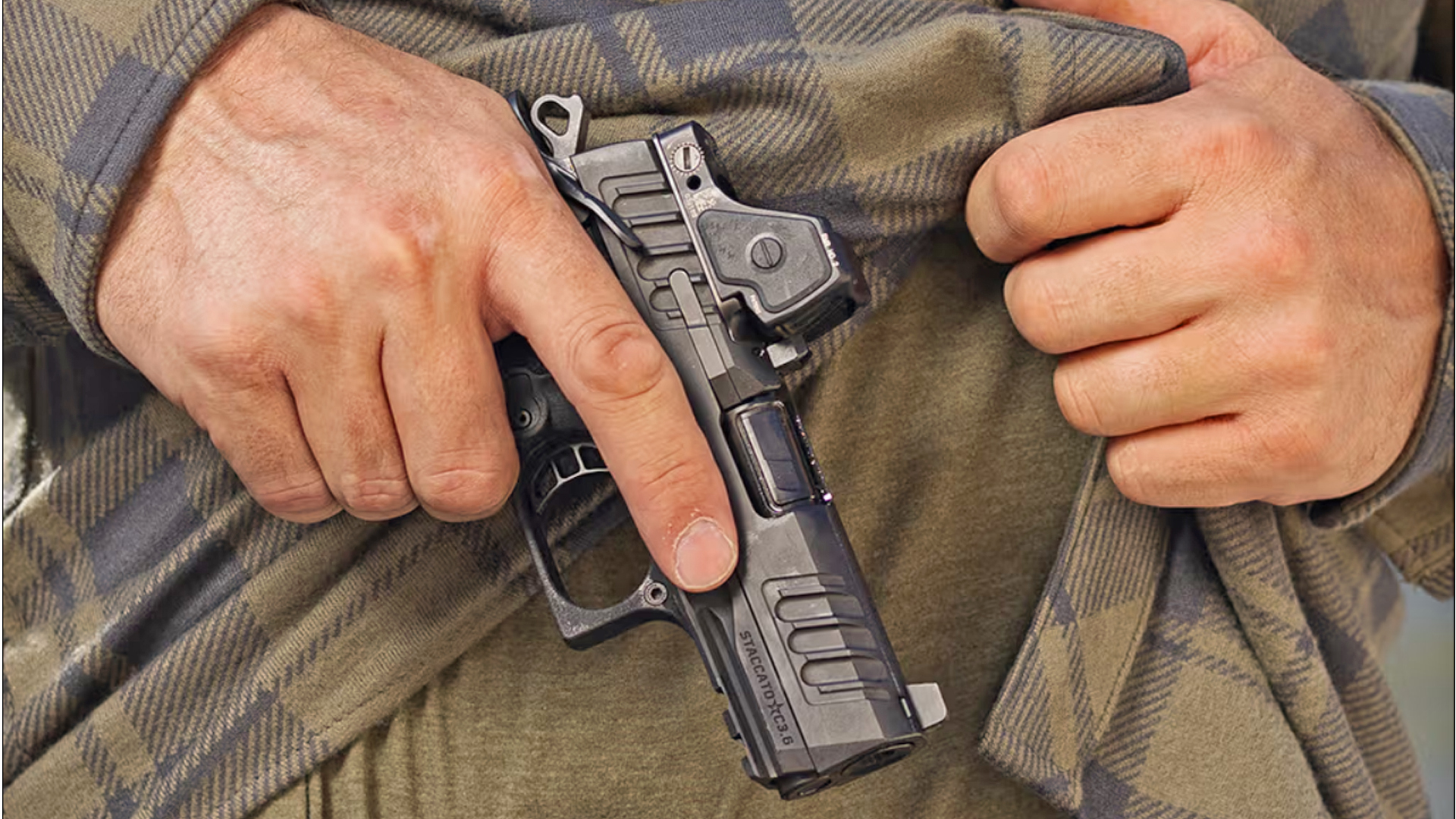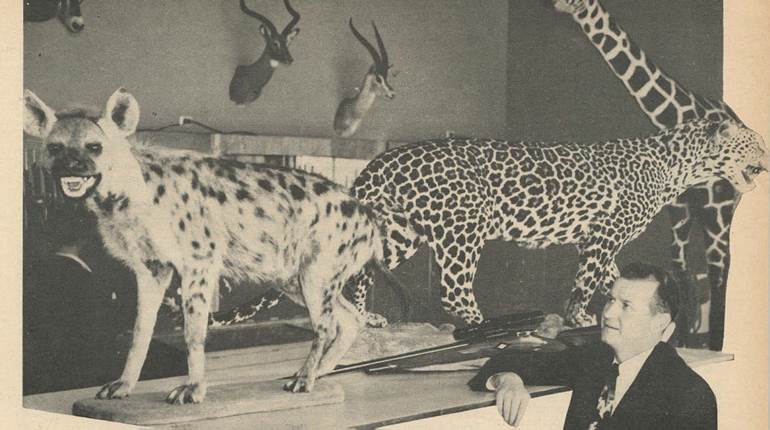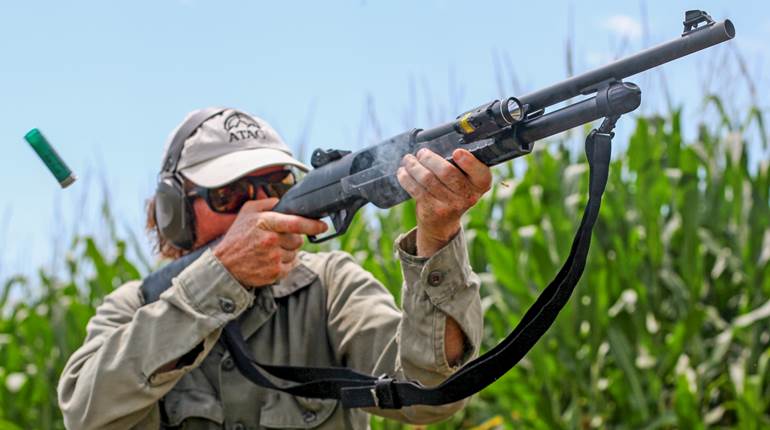
As his teammates hustle aboard their extraction Huey, a Special Forces recon man keeps his CAR-15 at the ready. Note its reversed, forward-mounted pistol grip—a typical modification. Many SOG men modified their arms as they saw fit.
 Some men’s best friends might be named Bill or Mike or Dave. But the best friend I ever had bore the unusual moniker, 905442. That was the serial number of my Colt Automatic Rifle-15, and “he” saved my life many times. For balance, pointing, ergonomics and just plain handiness, my CAR-15 was the finest combat weapon I ever used.
Some men’s best friends might be named Bill or Mike or Dave. But the best friend I ever had bore the unusual moniker, 905442. That was the serial number of my Colt Automatic Rifle-15, and “he” saved my life many times. For balance, pointing, ergonomics and just plain handiness, my CAR-15 was the finest combat weapon I ever used.
During the Vietnam War, our unit, MACV-SOG, was the only unit armed entirely with CAR-15s. The innocuously named Studies and Observations Group (SOG) was the war’s covert-actions organization, with its Green Berets running top secret missions deep behind enemy lines in Laos, Cambodia and, occasionally, North Vietnam.
With its distinctive retractable stock, short length, round handguard and cylindrical moderator, the CAR-15 became SOG’s icon and was carried with pride by the recon teams of U.S. Army Special Forces and indigenous soldiers. So long as he had his CAR-15 and one magazine, a SOG recon man was a force to be reckoned with—at least he reckoned he was.
Development
The CAR-15 employed the same receiver as the M16 rifle, but there its commonality ended. It was shorter overall —29.7" versus 39.6"—a pound lighter and included several unique features. What most distinguished the CAR-15 from its M16 cousin was its telescoping buttstock, patented in 1966 by its designer, Colt engineer Robert Roy. It had two simple settings: extended or retracted.
Instead of the M16’s foot-long, triangular handguard, the CAR’s was about half that length, 65⁄8", round and ribbed. And while the M16 had a three-prong or birdcage flash hider, the CAR-15 sported a unique 4¼" “moderator” of machined steel with six gas-vent slits and an expansion chamber. Unlike a standard flash suppressor, this moderator increased backpressure to more reliably run the action, while it also slightly reduced the CAR’s sound signature and acted as a counterweight. And, of course, it reduced muzzle flash. Though its sights were identical to the M16’s, the CAR’s shorter barrel reduced the sight radius—the distance from front to rear sight—from 19.75" to 15", somewhat degrading a shooter’s ability to aim precisely. This wasn’t a significant problem since our firefights almost always took place at 100 yds. or less.
Colt’s first CAR-15 version had a 10" barrel and, like the M16A1, included a forward bolt assist. When it was acquired by the U.S. Army in 1967, it was designated the XM177E1 with more than 2,800 fielded, mostly to U.S. Army Special Forces units. Internally, Colt called this version the Model 609. The U.S. Air Force, too, wanted the CAR-15 for its security police, but without the forward bolt assist. The Air Force designated this version the GAU-5A, while Colt called it the Model 610.
With all these 10"-barreled CARs in operators’ hands, assessments flowed back to Colt and the U.S. Army. The XM177E1 was still too loud and incapable of launching a rifle grenade, while, just like the M16, it sometimes experienced extraction problems that raised its chamber pressure above the specified 52,000 p.s.i.
To address these issues, Colt developed the CAR-15s final version, the XM177E2, dubbed by Colt the Model 629. First, the barrel was increased to 11.5", which notably reduced muzzle blast and sound signature; the chamber was chrome-plated to eliminate extraction problems; and a ring was installed behind the moderator to allow the firing of rifle grenades. This final version had a slightly longer overall length, adding 1.5", and a weight increase of about half a pound.
Colt manufactured 510 XM177E2s especially for SOG, ensuring that every recon team member had his own CAR-15.

Performance
The great benefit of the CAR-15 was its dexterity. After firing it extensively, day after day in live-fire training, the CAR’s three-round bursts seemed to dance from its muzzle. Though you used the sights, you hit targets not by aiming, but by thinking about aiming. Reflexes became so blazingly fast that the act preceded the thought—I once drew, fired and dropped a North Vietnamese soldier faster than I could recognize him, and only afterward did I realize he already had his AK trained on me when I fired.
With practice, a SOG recon man could drop an empty magazine with one hand, pull a fresh one with the other, slam it into his CAR-15 without even looking, slap the bolt release with the left palm and continue firing—in three seconds or less.
Despite the CAR-15’s excellent dexterity there were trade-offs. The XM177E2’s short barrel reduced the muzzle velocity of the 5.56x45 mm NATO M193 ball cartridge’s 55-gr. bullet from the standard 3250 f.p.s. to 2750 f.p.s., which reduced its maximum effective range by 50 meters and decreased its terminal effects proportionately. Still, in our experience it was plenty deadly for short-range engagements.

Of mixed benefit was the CAR’s cyclic rate of fire—up to 100 rounds-per-minute faster than the M16—which put extra rounds on target but also raised the possibility of a jam.
With the same rate of twist as the M16—one rotation per 12"—a bullet exited the CAR-15’s 11.5" barrel spinning 158,000 revolutions per minute, and it didn’t take much to tumble it. Tests by the U.S. Army Ballistic Lab showed that the CAR’s ball projectiles tended to yaw (tip sideways), and M196 tracer bullets yawed even more. This yawing may have deflected the bullet off trees and brush but it also inflicted dramatic wounds.
CAR-15 performance was also affected by its magazine pouch, which simply did not exist. Back then, the U.S. military issued surplus M14 magazine pouches, which obviously did not fit the M16 magazine but did save money. This was a problem not just for SOG warriors, but for all combat troops in Vietnam, with the smaller 20-round M16 magazines settling so deeply into the pouch that it was clumsy, almost impossible, to pull one out under fire. The jury-rig solution was to attach a tape tab or paracord loop to the magazine so it could be pulled out. While the M14 pouch was still useful because two hand grenades could be attached to it, the pouch held only four 20-round magazines, which were too few for those of us in SOG recon. Therefore, in combination with the M14 pouches, we also carried our 20-rounders in canteen covers that had been soaked and stretched to hold six magazines. Thus, two canteen covers and two M14 pouches could hold 20, 20-round magazines. With one 30-rounder in the carbine, that allowed for a total capacity of 430 total rounds, about double the M16’s basic load. While that may seem excessive, realize that the SOG recon man could not count on being re-supplied; deep behind enemy lines in Laos or Cambodia, he had only what he brought with him. As one who almost ran out of ammunition during a lengthy running firefight, I did not mind that extra weight at all.
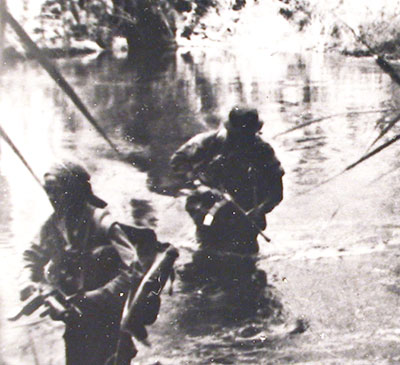
Reliability
Not once did 905442 fail me during a cross-border mission; I don’t know of a single instance of another SOG man’s CAR-15 malfunctioning, either. This was not pure luck.
We were well aware of the M16’s reputation for stoppages, and understood the primary cause: the CAR-15’s direct-impingement action blew dirty carbon and hot gas directly into the rifle’s most critical moving parts—the bolt and bolt carrier. Thus, we thoroughly cleaned our CAR-15s between missions.
A practice that served us well was firing our entire basic load while training between operations so that we drew fresh ammunition for the next mission. Equally important, this meant that we’d extensively test-fired our CAR-15s, sensitive to the slightest hint of a problem. Here is where I sometimes experienced stoppages. Of all the M16 reliability issues, scarcely mentioned has been the condition of magazine lips. Thrusting forward from its recoil spring, the bolt carrier needs enough velocity to grab a fresh round, push it forward and rotate the seven-lug bolt shut; if it encounters a bent magazine lip, the additional drag could slow the bolt carrier and cause it to fail to chamber a fresh round. I encountered this several times during live-fire training and would instantly eject the magazine and fire a round into it so no one else might use it. These were the only stoppages I ever experienced.

Some other reliability practices may have been more superstitious than practical. Like many infantrymen in Vietnam, we loaded 19 rounds into our 20-round magazines, suspecting that the follower spring might be too weak to lift a 20th round. I don’t know that we ever tested this assumption, but ask yourself, do you want to tempt fate?
Another superstition was some men’s belief that if the gaps in the bolt’s three piston rings were aligned, enough gas might escape to cause a stoppage. Thus, while re-assembling a cleaned gun, they would use a toothpick to arrange the rings in such a way that the gaps did not align.
By contrast, it was not superstitious that we test-fired our arms before boarding an insertion helicopter and then taped the muzzles to protect them from inadvertent blockage. And during a mission, every morning I flipped my safety to ensure it was operating properly and then slightly broke the seal between the loaded round and the chamber just in case accumulated dew had pushed the cartridge beyond headspace. We did not usually carry cleaning gear to the field, but one man per team had a cleaning rod taped below his handguard just in case a bore became plugged.

Accoutrements And Optics
Late in the war, single-shot grenade launchers that could be mounted below an M16’s handguard began arriving in Vietnam. The first launcher, the XM148, was co-designed by Robert Roy, the same Colt engineer who gave birth to the CAR-15. Later, a more advanced grenade launcher, the XM203, was fielded as well. Though meant to fit beneath the M16’s foot-long handguard, industrious SOG recon men found they could fit these grenade launchers on the CAR-15 despite their much shorter handguards, and some teams soon replaced their two M79 grenade launchers with XM148s or XM203s, in theory gaining extra CAR-15 shooters in the process. Being “old school,” I didn’t like this because it was detrimental to both arms; this imbalanced the CAR-15, while the grenade launcher could not achieve the firing rate or consistent accuracy of an M79 by a well-trained Montagnard.

Besides, rifle grenades were far deadlier than 40 mm grenade rounds, and unlike the CAR’s earlier versions, the XM177E2 could accommodate them quite handily. Some team leaders had one or two men keep a rifle grenade on their CAR-15s for fast employment during a firefight. To propel the grenade, a special crimped 5.56 mm cartridge was required, but it produced too little gas pressure to operate the action. Thus, after launching the grenade the shooter manually ejected the crimped case and chambered the next cartridge, which was a live ball round.
SOG recon men were always experimenting and innovating, which included installing optical sights on their CAR-15s despite the logistics system lacking any kind of mount. Staff Sergeant Bill Gabbard, leading a mission in a relatively open area of Laos, somehow mounted a civilian 3-9X scope atop his CAR-15. I have no idea where he found the mount.
Night firing was a problem for the Son Tay Raiders, the Green Berets who attempted the rescue of American POWs just 23 miles outside Hanoi in November 1970. Many of them SOG veterans, they were armed with the U.S. Air Force version of the CAR-15. When they found the ideal night optic—the Singlepoint Night Sight—they learned there was no mount in the system for installing it onto their carbines. They custom made their own mounts using ordinary electrical tape, and the sights worked just fine.

Many SOG recon men experimented with their CAR-15s, such as installing a CAR-15 upper onto an M16 lower to create an excellent-handling mini-M16. It would have upset the CAR-15 developers, but several SOG Green Berets replaced their carefully designed moderators with birdcage flash suppressors to create a roaring, fire-breathing muzzle blast, allegedly for psychological effect. To improve control during full-automatic firing, some recon men installed a reversed M16 pistol grip beneath their CAR-15 handguard, much like the forward grip on an M1928 Thompson submachine gun.
Ideas and modifications never seemed to end, but one thing these men all had in common was their high regard for this SOG icon that saved their lives, the CAR-15. And what became of my best friend, my CAR-15? After SOG disbanded in 1972, most of our XM177E2s were collected and shipped back to the States. I hope my trusty old 905442 was among them.

 New Editions Of Plaster’s Secret Commandos And SOG
New Editions Of Plaster’s Secret Commandos And SOG
During a recent conversation with my friend Maj. John L. Plaster, USAR (Ret.), I asked, “John, you carried the Swedish K in Vietnam, right?” He answered crisply, “No. Not correct. I carried it in Laos ... but I wasn’t able to talk about that for a long time.” That’s because the missions he was running were top secret.
Before Maj. Plaster developed a training regimen as a Special Forces reservist that led to The Ultimate Sniper, he was a U.S. Army Special Forces sergeant who served three combat tours with the Military Assistance Command Vietnam-Studies and Observation Group (MACV-SOG)—the Vietnam War’s covert operations unit. SOG inserted small teams deep behind enemy lines in Laos and Cambodia along the heavily defended Ho Chi Minh Trail highway system. At times outnumbered 100-to-1, to accomplish these top secret hazardous missions, SOG’s Green Berets developed specialized arms, tactics and techniques that proved so effective that many are used by today’s Special Forces.
As a recon team leader, Plaster ran 22 missions behind enemy lines on the ground, then he flew 350 mission as a forward air controller. He has been inducted into the U.S. Army Special Forces and U.S. Air Force Air Commando Ass’n halls of fame.
A frequent contributor to American Rifleman and one of the finest writers I know, Plaster set out to tell the stories of the men he served with in SOG—both Army Special Forces and the indigenous troops—once their missions were declassified in the early 1990s. He did so in two books that are some of the best I’ve read. Both of Maj. Plaster’s books on his time with SOG have been released in paperback editions by Simon and Schuster. Secret Commandos: Behind Enemy Lines With The Elite Warriors Of SOG has 432 pps. while SOG: The Secret Wars Of America’s Commandos In Vietnam has 432 pp. and both measure 6"x9". The cost is $20 each plus shipping, and they are available autographed by the author at ultimatesniper.com.
—Mark A. Keefe, IV, Editor In Chief












